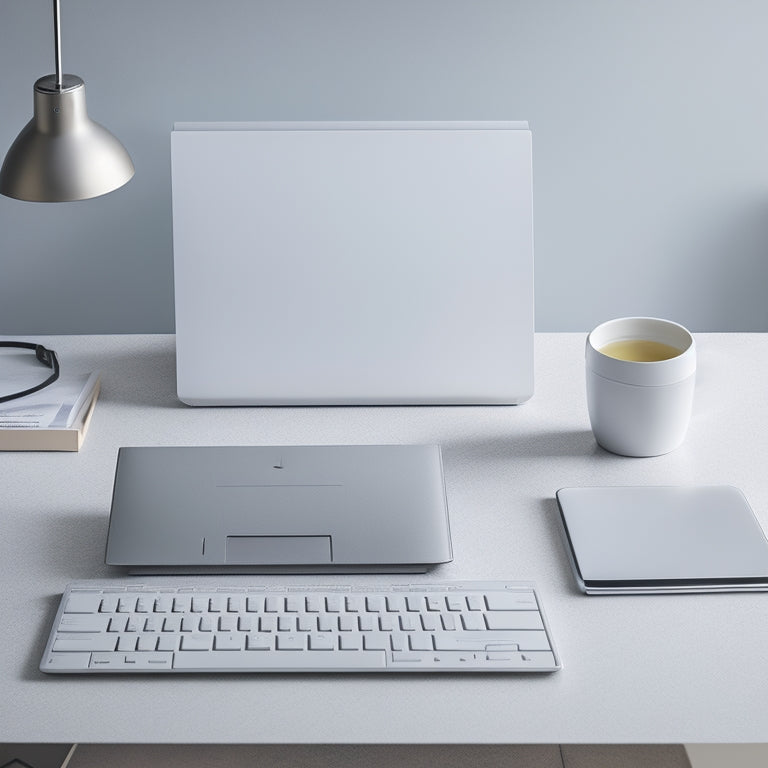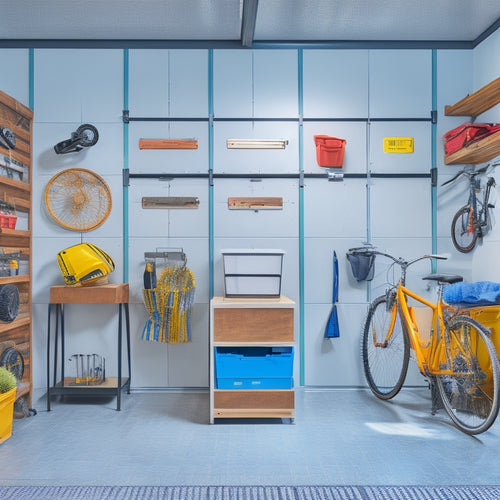
Time-Saving Organization Solutions for Busy Professionals
Share
You're wasting nearly 6 weeks of productivity annually due to poor organization, so it's crucial to streamline your digital life by decluttering files, implementing digital task management tools, and maintaining a consistent folder structure. Command your email inbox by setting up filters, aiming for "inbox zero," and dedicating time to manage your emails daily. Tame paperwork by categorizing documents, digitizing, and securely storing sensitive files. Schedule like a pro by calendar blocking and time tracking, and maximize your workspace with a minimalist design approach. By implementing these time-saving organization solutions, you'll gain more productive hours - and there's even more to investigate ahead.
Key Takeaways
- Implement digital decluttering by organizing computer files into clear folders and removing redundant files to reduce digital clutter.
- Utilize digital task management tools like Trello to enhance task organization and implement the "one touch rule" for efficient task management.
- Optimize your email inbox by setting up filters, achieving "inbox zero", and dedicating time each day to manage emails effectively.
- Employ calendar optimization techniques like calendar blocking and task batching to maximize productivity and visualize time commitments.
- Establish a structured task management system, identify tasks for delegation, and implement habit tracking to monitor progress and stay focused on priorities.
Streamlining Your Digital Life
Nearly 70% of your waking hours are spent staring at screens, from laptops to smartphones. It's no wonder you feel overwhelmed by the constant stream of online information. To regain control, implement digital decluttering strategies to simplify your virtual life.
Start by organizing your computer files into clear folders and subfolders, and consider cloud storage solutions like Google Drive or Dropbox to access files from anywhere.
Next, tackle your phone by deleting unused apps, categorizing others into folders, and setting up automatic backups. This will help you quickly find what you need and reduce digital stress.
Take it a step further by implementing a "one touch rule" – deal with each digital task or notification as soon as you open it, either by responding, delegating, or archiving.
Mastering Your Email Inbox
Your email inbox is a breeding ground for digital clutter, with unread messages, spam, and forgotten threads cluttering up your digital space. It's crucial to tame this beast to stay on top of your work and reduce stress.
Start by setting up email filters to automatically sort, forward, or delete incoming messages based on specific criteria, such as sender, subject, or keyword. This will help you focus on critical emails and avoid wasting time on non-essential ones.
Next, aim for inbox zero, where you regularly clear out your inbox by responding, delegating, or archiving emails. This will give you a sense of control and clarity.
To achieve this, set aside dedicated time each day to tackle your inbox, and use the 2-minute rule: if an email requires less than 2 minutes to respond to, do it immediately. For longer responses, schedule a task or add it to your to-do list.
Taming the Paperwork Beast
Conquering the paperwork beast requires a strategic approach to tame the clutter and chaos that can engulf your workspace. To start, implement a paper management system that categorizes documents into "must-keep," "should-keep," and "recycle" piles. This helps you prioritize document retention and identify what can be digitized or discarded.
Next, set up a filing system that makes sense for your work style. This might include color-coded folders, labeled bins, or a digital filing system. Invest in organization tools like file organizers, desk trays, and paper trays to keep your workspace tidy.
Consider paperwork automation tools that can digitize documents, freeing up physical storage space. For documents that require physical storage, invest in office supplies like fireproof safes or locking file cabinets to guarantee secure record keeping.
Regularly review your documents and shred or recycle what's no longer needed. By implementing these strategies, you'll be well on your way to taming the paperwork beast and reclaiming control over your workspace.
Scheduling Like a Pro
You're about to change your calendar into a powerful productivity tool. By controlling your calendar, you'll be able to visualize your time commitments, identify pockets of availability, and make intentional decisions about how you allocate your time.
Next, you'll learn how to prioritize your tasks, ensuring that you're tackling the most critical ones first and making the most of your time.
Master Your Calendar
Within the structure of your daily routine, a well-organized calendar serves as the backbone of productivity, allowing you to allocate time efficiently and prioritize tasks effectively. By mastering your calendar, you'll be able to schedule your day with precision, ensuring that you have enough time for everything.
To get started, try calendar blocking, a technique where you reserve large blocks of uninterrupted time for focused work. This allows you to tackle complex tasks without distraction. Here's an example of how you can structure your calendar:
| Time | Task | Duration |
|---|---|---|
| 9:00 am | Check and respond to urgent emails | 30 minutes |
| 9:30 am | Calendar blocking for focused work | 2 hours |
| 11:30 am | Meeting with team members | 1 hour |
| 1:00 pm | Lunch break | 1 hour |
Prioritize Your Tasks
By categorizing tasks based on their level of importance and deadlines, you can maximize your productivity and achieve more in less time. This helps you distinguish between urgent vs important tasks, focusing on the most critical ones first.
Create a task list, and label each item as high, medium, or low priority. Then, group similar tasks together using task batching. This technique involves completing similar tasks in one session, reducing shift time and increasing efficiency. For instance, check and respond to all emails at once, rather than constantly throughout the day.
Prioritize your tasks by considering the deadlines and consequences of not completing them on time. Identify the most critical tasks that require immediate attention, and tackle them first.
Maximizing Your Workspace
You'll work more efficiently when your workspace is optimized for productivity.
Start by maximizing your desk real estate, reserving prime space for essential items and relegating less-used items to secondary areas.
Additionally, keep ergonomic essentials, like a comfortable keyboard and mouse, within easy reach to prevent fatigue and distraction.
Optimize Desk Real Estate
About 80% of your workday is spent at your desk, making it an essential area to optimize for maximum productivity. To optimize your desk real estate, adopt a minimalist design approach. Remove any unnecessary items and keep only essential desk accessories, such as a paper tray, pen holder, and productivity tools like a timer or planner.
Implement efficient cable management by using cable organizers or zip ties to keep cords tidy. This will help create a clutter-free environment, allowing you to focus on your work.
Add personal touches, such as a small plant or a framed photo, to make your workspace feel welcoming. However, be mindful not to overdo it, as too many distractions can hinder your productivity.
Consider an L-shaped or U-shaped desk layout to create a focused workspace. This will help you stay organized and efficient, allowing you to tackle tasks quickly.
Ergonomic Essentials Nearby
Three essential items should always be within arm's reach to maximize your workspace: a comfortable keyboard tray, a supportive backrest, and a well-positioned monitor.
These ergonomic tools will help you maintain proper posture, reducing the risk of discomfort, fatigue, and even long-term injuries. By making comfort adjustments, you'll be able to work for extended periods without distraction, leading to productivity enhancements.
In addition to promoting workspace wellness, having these essentials nearby will also encourage mindful organization.
You'll be more likely to maintain an efficient layout, keeping frequently used items within easy reach and minimizing clutter. This, in turn, will help you stay focused and avoid wasting time searching for misplaced items.
Task Management Essentials
Productivity hinges on the ability to effectively manage tasks, and a well-structured system is the backbone of this process. You need a clear plan to tackle your daily tasks, prioritize them, and allocate sufficient time for each one.
Start by identifying the tasks that can be delegated to others, and develop task delegation strategies that work for you. This will help you free up time and focus on high-priority tasks.
Next, implement productivity tracking tools to monitor your progress and stay on track. These tools can help you identify areas where you're wasting time, and make adjustments to optimize your workflow.
Consider using digital tools like Trello or Asana to visualize your tasks, set deadlines, and track your progress. You can also use time-tracking software to monitor how much time you're spending on each task.
Building Productive Habits
Developing a routine of productive habits is essential to sustaining your task management system, as it enables you to perform tasks efficiently and make the most of your time.
To build these habits, start by setting clear goals and breaking them down into smaller, manageable tasks. Use habit tracking to monitor your progress and identify areas for improvement. Find an accountability partner to provide support and encouragement.
Begin each day with a morning routine that sets a positive tone, such as meditation or exercise. End each day with an evening ritual, like reflection or journaling, to unwind and prepare for the next day.
Implement mindfulness techniques to stay focused and present. Use time blocking to schedule tasks and make the most of your time. Celebrate your achievements with positive reinforcement to motivate yourself to continue.
Consistency is key, so establish routines and stick to them. By incorporating these strategies into your daily routine, you'll be well on your way to developing productive habits that will help you achieve your goals and reduce stress.
Decluttering Your Digital Files
As you investigate the world of digital organization, you'll soon realize that decluttering your digital files is an essential step towards streamlining your workflow and reducing digital clutter. This process is more than just deleting unnecessary files; it's about creating a system that promotes efficiency, productivity, and data security.
Start by implementing a logical folder structure and consistent file naming convention. This will enable you to locate files quickly and easily, saving you time and reducing frustration.
Next, eliminate redundant files and outdated versions, ensuring you have only the most current and relevant documents. Consider implementing version control to track changes and maintain a record of updates.
Don't forget to backup your files using cloud storage or other reliable solutions to prevent data loss in case of an emergency.
This digital detox won't only free up space on your devices but also reduce stress and anxiety related to digital clutter. By organizing your digital files, you'll be able to focus on high-priority tasks, confident that your data is secure and easily accessible.
Frequently Asked Questions
How Do I Avoid Procrastination When Faced With Overwhelming Tasks?
When faced with overwhelming tasks, you break them down into manageable chunks, identifying the smallest step you can take. Then, you use motivation techniques like the Pomodoro Technique to enhance focus and momentum, helping you stay on track and avoid procrastination.
Can I Use One Calendar for Both Personal and Professional Scheduling?
You can use one calendar for both personal and professional scheduling, achieving calendar integration and scheduling balance by separating events with distinct colors, labels, or categories, ensuring a clear visual distinction between your work and personal life.
What Are Some Alternatives to Traditional To-Do Lists for Task Management?
You're looking for alternatives to traditional to-do lists! Consider task management techniques like Kanban boards, mind maps, or Eisenhower matrices, which offer visual planning methods to prioritize and organize your tasks, helping you stay focused and in control.
How Can I Prioritize Tasks When Everything Seems Equally Important?
You're drowning in a sea of equal priorities, but don't let tasks overwhelm you. Use urgency assessment techniques to identify must-dos, then delegate tasks strategically, freeing you to focus on high-impact activities that drive results.
Are There Any Productivity Apps Suitable for Individuals With Limited Tech Skills?
You can find simple productivity apps that cater to your limited tech skills; look for user-friendly apps like Todoist, Trello, or Any.do, which offer intuitive interfaces and guided onboarding processes to get you started quickly and safely.
Conclusion
You've tamed the chaos, and your productivity has skyrocketed! With these time-saving organization solutions, you'll be a whiz in your domain, with hours of free time to spare (okay, maybe not hours, but you get the idea!). Seriously, though, by streamlining your digital life, mastering your email inbox, and scheduling like a pro, you'll be able to tackle even the most intimidating tasks with ease. Now, go forth and conquer your to-do list!
Related Posts
-

3 Pro Garage Organization Ideas to Try Now
You can alter your garage from cluttered chaos to organized oasis with three pro garage organization ideas. First, op...
-

Top 5 Small Tool Organizers for Your Workshop
You're looking to optimize your workshop's efficiency with high-quality small tool organizers. Compact storage soluti...
-

Top Rolling Tool Box Drawers for Maximum Storage
When it comes to maximizing storage with rolling tool box drawers, you need a solution that combines durability, cust...


